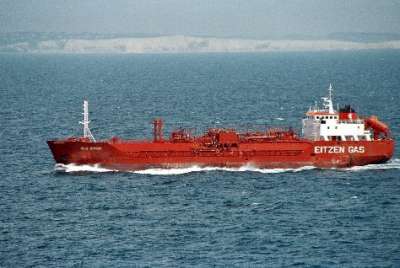
Fig: Gas carrier Sigas Ettrick underway
During the initial period of vaporisation of the gas, ignition may be accompanied by a flash of varying proportions.However, because the velocity of propagation of a flame is lower in methane than in other hydro-carbon gases, it is unlikely that future ignition will have flash effect.
The fire-fighting plan should be well thought out in advance and a concentrated effort made rather than ‘hit and run’ tactics, as these will only consume the vessel’s extinguishing facilities without extinguishing the fire. Before attempting to tackle a large fire, you should seriously consider allowing the fire to burn itself out.
Boiling liquid expanding vapor explosion (BLEVE) is a phenomenon associated with uninsulated pressurized tanks, such as propane tanks. When the uninsulated tank is subjected to an external fire, pressure in the tank will rapidly rise and ultimately cause its rupture. The insulation around LNG tanks is used to minimize the evaporation of LNG during ocean transit. This insulation will also insulate the liquefied natural gas cargo in the presence of an external fire and will limit the rate of rise of the internal tank pressure. In the event that some of the insulation is compromised, LNG tanks are equipped with pressure-relief valves. Venting through these is designed to keep the pressure within an acceptable range to prevent the tank from exploding.
Should an attempt to extinguish the fire be made, extensive use of ‘dry powder’ should be employed from as many dispensers as can be brought to bear. Fire-fighters should be well protected against heat radiation and possible flash burns, and approach the fire from an upwind direction. Power dispensers should sweep the entire area of the fire, but direct pressure of powder jets on to the surface of the liquid should be avoided.
Should dry powder guns be used, fire-fighters should be well practised in their use and be prepared for some kick-back effect.They should also be made aware that there is no cooling effect from the use of dry powder, and that re-ignition after a fire has been extinguished is a distinct possibility.
In the initial stages it is always preferable to isolate the fire by shutting off the source of fuel.This may not, however, always be possible. A final warning when tackling an LNG fire is that water should not be used directly, as this will accelerate vaporisation of the liquid.This is not to say that surrounding bulkheads and decks cannot be cooled down with water sprays, provided that water running off is not allowed to mix with burning LNG.
Related Information:
- Guideline to tackle fire on board LNG ship
- Training requirements LNG carriers
- Design characteristics of liquefied gas carriers
- Liquefied gas carrier -applicable regulations
- Vapour Characteristics of liquefied gases
- Personal protective equipments for people working onboard gas carriers
- Low temperature effects of Liquefied gases
- Reactivity of liquefied gas cargo and safety guideline
Safety equipment
Liquefied gas cargo reactivity
Liquefied gas cargo corrosion
Liquefied gas cargo vapour characteristics
Liquefied gas cargo - low temperature effects
Liquefied gas carrier -monitoring cargo pressure
External links :
// Home page/// LNG handling /// LPG handling/// Sea transport /// Gas products///
Cargo work ///Fire precautions ///Health hazards ///Safety Precautions
///Emergency response ///
Copyright © Liquefied Gas Carrie.com All rights reserved.
The content published in this website are for general reference only. We have endeavoured to make the information as accurate as possible but cannot take responsibility for any errors. For latest information please visit www.imo.org . Any suggestions, please Contact us !
///Links &Resources // Terms of use/// Privacy policy///Home page///